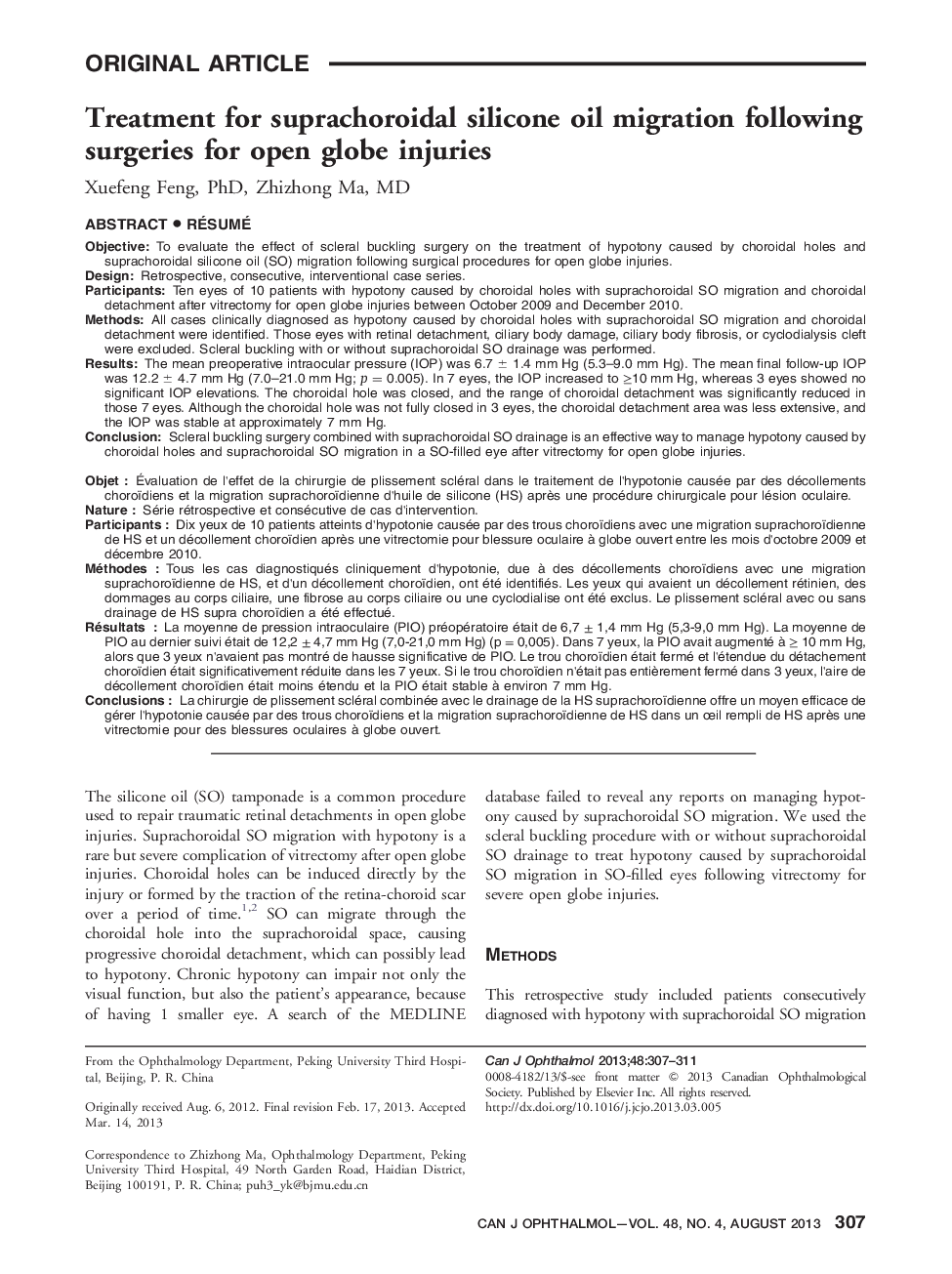| کد مقاله | کد نشریه | سال انتشار | مقاله انگلیسی | نسخه تمام متن |
|---|---|---|---|---|
| 4009535 | 1602408 | 2013 | 5 صفحه PDF | دانلود رایگان |

ObjectiveTo evaluate the effect of scleral buckling surgery on the treatment of hypotony caused by choroidal holes and suprachoroidal silicone oil (SO) migration following surgical procedures for open globe injuries.DesignRetrospective, consecutive, interventional case series.ParticipantsTen eyes of 10 patients with hypotony caused by choroidal holes with suprachoroidal SO migration and choroidal detachment after vitrectomy for open globe injuries between October 2009 and December 2010.MethodsAll cases clinically diagnosed as hypotony caused by choroidal holes with suprachoroidal SO migration and choroidal detachment were identified. Those eyes with retinal detachment, ciliary body damage, ciliary body fibrosis, or cyclodialysis cleft were excluded. Scleral buckling with or without suprachoroidal SO drainage was performed.ResultsThe mean preoperative intraocular pressure (IOP) was 6.7 ± 1.4 mm Hg (5.3–9.0 mm Hg). The mean final follow-up IOP was 12.2 ± 4.7 mm Hg (7.0–21.0 mm Hg; p = 0.005). In 7 eyes, the IOP increased to ≥10 mm Hg, whereas 3 eyes showed no significant IOP elevations. The choroidal hole was closed, and the range of choroidal detachment was significantly reduced in those 7 eyes. Although the choroidal hole was not fully closed in 3 eyes, the choroidal detachment area was less extensive, and the IOP was stable at approximately 7 mm Hg.ConclusionScleral buckling surgery combined with suprachoroidal SO drainage is an effective way to manage hypotony caused by choroidal holes and suprachoroidal SO migration in a SO-filled eye after vitrectomy for open globe injuries.
RÉsumÉObjetÉvaluation de l'effet de la chirurgie de plissement scléral dans le traitement de l'hypotonie causée par des décollements choroïdiens et la migration suprachoroïdienne d'huile de silicone (HS) après une procédure chirurgicale pour lésion oculaire.NatureSérie rétrospective et consécutive de cas d'intervention.ParticipantsDix yeux de 10 patients atteints d'hypotonie causée par des trous choroïdiens avec une migration suprachoroïdienne de HS et un décollement choroïdien après une vitrectomie pour blessure oculaire à globe ouvert entre les mois d'octobre 2009 et décembre 2010.MéthodesTous les cas diagnostiqués cliniquement d'hypotonie, due à des décollements choroïdiens avec une migration suprachoroïdienne de HS, et d'un décollement choroïdien, ont été identifiés. Les yeux qui avaient un décollement rétinien, des dommages au corps ciliaire, une fibrose au corps ciliaire ou une cyclodialise ont été exclus. Le plissement scléral avec ou sans drainage de HS supra choroïdien a été effectué.RésultatsLa moyenne de pression intraoculaire (PIO) préopératoire était de 6,7 ± 1,4 mm Hg (5,3-9,0 mm Hg). La moyenne de PIO au dernier suivi était de 12,2 ± 4,7 mm Hg (7,0-21,0 mm Hg) (p = 0,005). Dans 7 yeux, la PIO avait augmenté à ≥ 10 mm Hg, alors que 3 yeux n'avaient pas montré de hausse significative de PIO. Le trou choroïdien était fermé et l'étendue du détachement choroïdien était significativement réduite dans les 7 yeux. Si le trou choroïdien n'était pas entièrement fermé dans 3 yeux, l'aire de décollement choroïdien était moins étendu et la PIO était stable à environ 7 mm Hg.ConclusionsLa chirurgie de plissement scléral combinée avec le drainage de la HS suprachoroïdienne offre un moyen efficace de gérer l'hypotonie causée par des trous choroïdiens et la migration suprachoroïdienne de HS dans un œil rempli de HS après une vitrectomie pour des blessures oculaires à globe ouvert.
Journal: Canadian Journal of Ophthalmology / Journal Canadien d'Ophtalmologie - Volume 48, Issue 4, August 2013, Pages 307–311